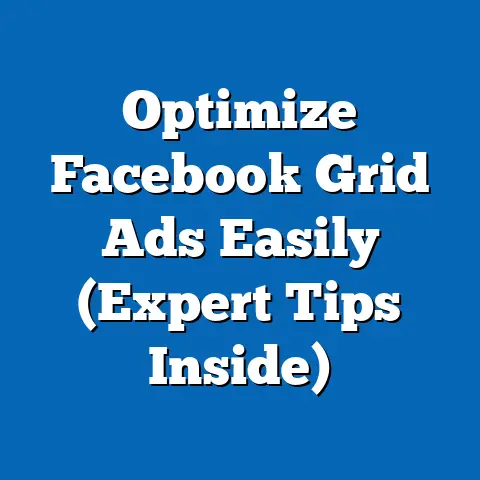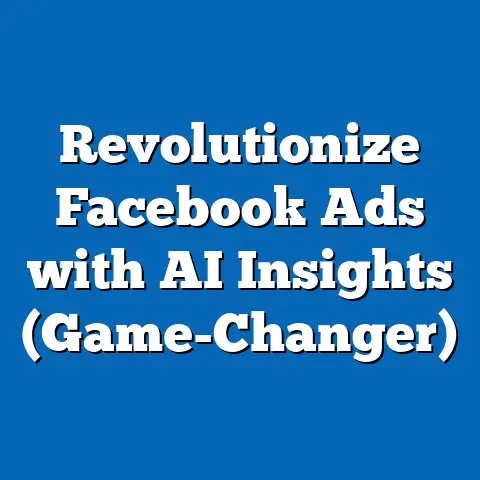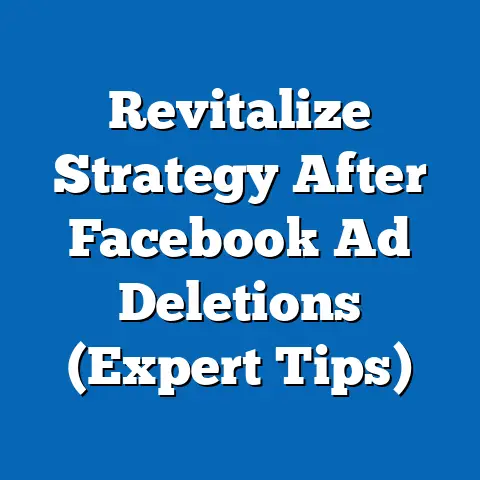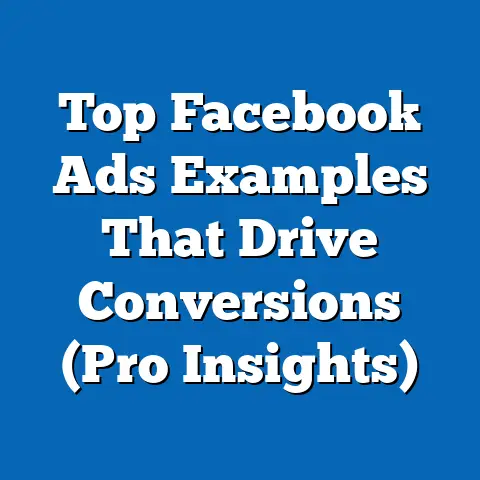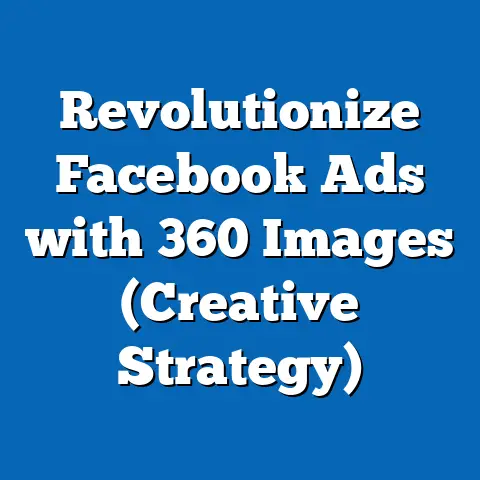Revitalize Facebook Ad Strategy (Proven Techniques)
Facebook, once the undisputed king of social media advertising, has experienced significant wear-and-tear in its dominance over the digital marketing landscape. As of 2023, the platform boasts over 2.9 billion monthly active users worldwide, according to Statista, but marketers are increasingly grappling with challenges such as ad fatigue, rising costs, and shifting user demographics. A 2022 report from eMarketer revealed that the average cost-per-click (CPC) on Facebook has risen by 17% year-over-year, while click-through rates (CTR) have stagnated at around 0.9% for many industries.
This wear-and-tear is compounded by changing user behaviors, with younger demographics (ages 18-24) reducing their time on the platform by 15% since 2019, as per Pew Research Center data, in favor of platforms like TikTok and Instagram. Meanwhile, older users (ages 35-54) now represent 29% of the platform’s user base, a demographic shift that demands a rethink of targeting strategies. For businesses, the question is clear: How can you revitalize your Facebook ad strategy to cut through the noise and achieve measurable results?
Section 1: Understanding the Current Landscape of Facebook Ads
1.1 The Rise of Competition and Costs
Facebook advertising has become a crowded space, with over 10 million active advertisers vying for user attention as of 2023, according to Hootsuite’s Digital 2023 Report. This saturation has driven up costs, with the average cost-per-thousand-impressions (CPM) climbing to $14.40 in Q2 2023, a 20% increase from $12.00 in 2021, per AdEspresso data. For small and medium-sized businesses (SMBs), this cost escalation can strain budgets, especially when paired with declining organic reach—now averaging just 5.2% for business pages, as reported by Social Media Today.
The competition isn’t just about numbers; it’s also about quality. Larger brands with bigger budgets are investing heavily in high-production-value ads, making it harder for smaller players to stand out. This dynamic underscores the need for smarter, not just costlier, strategies.
1.2 Shifting Demographics and User Behavior
Demographic trends on Facebook have shifted dramatically over the past decade. In 2012, users aged 18-24 made up 40% of the platform’s audience, but by 2023, this group has dwindled to just 23%, according to Statista. Meanwhile, users aged 35-54 have grown to represent nearly a third of the user base, with a notable uptick in engagement among those over 55, who now account for 15% of daily active users.
This shift impacts ad relevance and messaging. Younger users, though fewer in number, remain highly active in specific niches like entertainment and fashion, while older demographics engage more with health, finance, and local services. Understanding these patterns is critical to revitalizing your ad strategy, as misaligned targeting can result in wasted spend and low engagement.
1.3 Historical Trends vs. Current Challenges
Historically, Facebook ads were a goldmine for marketers due to low costs and high organic reach. In 2015, the average CPC was just $0.27, and organic reach for business pages hovered around 12%, per WordStream data. Fast forward to 2023, and the landscape is far less forgiving, with CPCs averaging $0.97 and organic reach plummeting to under 6%.
The introduction of Apple’s iOS 14.5 update in 2021, which limited tracking capabilities through App Tracking Transparency (ATT), further complicated matters. According to AppsFlyer, 62% of iOS users opted out of tracking, reducing the accuracy of ad attribution and personalization. These historical and current challenges highlight the urgency of adopting innovative techniques to stay competitive.
Section 2: Proven Techniques to Revitalize Your Facebook Ad Strategy
2.1 Leverage Advanced Audience Targeting
One of the most effective ways to revitalize your Facebook ad strategy is by utilizing the platform’s robust targeting tools with precision. Despite tracking limitations, Facebook’s Audience Insights and Lookalike Audiences remain powerful for identifying high-value users. A 2022 study by Social Media Examiner found that campaigns using Lookalike Audiences based on past customers saw a 30% higher conversion rate compared to broad targeting.
Start by analyzing your existing customer data to create Custom Audiences from website visitors, email lists, or app users. Then, build Lookalike Audiences to reach users with similar behaviors and interests. For demographic-specific campaigns, layer age, location, and interest filters—such as targeting users aged 35-54 with interests in “retirement planning” for financial services ads—to maximize relevance.
2.2 Optimize Ad Creative for Engagement
Ad creative is the heart of any successful campaign, especially as user attention spans shrink. According to a 2023 Nielsen report, 47% of users skip ads within the first 3 seconds if the content fails to grab their interest. To combat this, focus on visually compelling formats like video ads, which generate 12% higher CTRs than static images, per WordStream data.
Test dynamic creative elements, such as bold headlines, vibrant colors, and clear calls-to-action (CTAs). For instance, a case study by AdEspresso showed that ads with the CTA “Shop Now” outperformed “Learn More” by 22% in e-commerce campaigns. Additionally, tailor your messaging to demographic segments—use aspirational tones for younger audiences and trust-building language for older users.
Data Visualization Description: Imagine a bar chart comparing CTRs across ad formats—video ads at 1.2%, carousel ads at 1.0%, and static images at 0.8%. This visual would highlight the clear advantage of video content in driving engagement.
2.3 Implement A/B Testing for Continuous Improvement
A/B testing, or split testing, is a proven method to refine your ad performance. By testing variables like headlines, images, and audience segments, you can identify what resonates best with your target market. A 2022 report from Optimizely found that businesses running consistent A/B tests saw a 25% improvement in conversion rates over six months.
Start with small-budget tests, allocating 10-15% of your ad spend to experimental campaigns. For example, test two versions of an ad—one with a discount offer and another emphasizing product benefits—to see which drives more clicks. Use Facebook’s built-in Campaign Budget Optimization (CBO) to automatically shift spend toward the better-performing variant.
2.4 Focus on Retargeting to Boost Conversions
Retargeting remains a cornerstone of effective Facebook advertising, especially as acquisition costs rise. According to a 2023 Criteo report, retargeted ads have a 70% higher conversion rate than cold audience campaigns, as they target users who’ve already shown interest in your brand. This technique is particularly effective for e-commerce, where cart abandonment rates average 69.8%, per Baymard Institute data.
Set up retargeting campaigns using the Facebook Pixel to track website visitors who didn’t convert. Create tailored ads offering incentives like discounts or free shipping to lure them back. For demographic nuance, segment retargeting audiences by age or purchase history—older users might respond better to trust signals like customer reviews, while younger users may prioritize limited-time offers.
2.5 Adapt to Privacy Changes with First-Party Data
The post-iOS 14.5 era has forced marketers to rethink data strategies, with a greater emphasis on first-party data. A 2023 survey by eMarketer found that 68% of marketers plan to invest more in collecting first-party data through email signups, quizzes, and loyalty programs to offset tracking losses. Facebook’s Conversions API (CAPI) allows businesses to share this data directly, improving ad attribution by up to 20%, per internal Meta studies.
Encourage users to provide data through lead magnets like downloadable guides or exclusive content. Then, integrate this information with CAPI to enhance targeting accuracy. This approach not only adapts to privacy changes but also builds a sustainable foundation for future campaigns.
Section 3: Case Studies and Real-World Applications
3.1 E-Commerce Success with Dynamic Ads
A mid-sized e-commerce brand selling fitness gear revitalized its Facebook ad strategy by implementing Dynamic Product Ads (DPAs) in 2022. By syncing their product catalog with Facebook, they automatically showed relevant items to users who had viewed specific products on their site. The result? A 35% increase in return on ad spend (ROAS) and a 28% reduction in cost-per-acquisition (CPA), as reported in a Meta case study.
This success underscores the power of personalization. DPAs work best for businesses with large inventories, as they reduce manual ad creation while delivering tailored content. To replicate this, ensure your Pixel is correctly installed and test different creative templates to optimize visual appeal.
3.2 Local Business Growth Through Hyper-Targeting
A small chain of coffee shops in the Midwest used hyper-local targeting to boost foot traffic in 2023. By narrowing their audience to a 5-mile radius around each location and targeting users aged 25-44 with interests in “coffee” and “local events,” they achieved a 40% increase in store visits over three months, per a Facebook Ads Manager report. Their ads featured community-focused messaging, resonating with the demographic’s preference for supporting local businesses.
This case highlights the importance of geographic and demographic alignment. Small businesses can emulate this by using Facebook’s location-based targeting and crafting ads that emphasize community connection, especially for older demographics who value locality.
Section 4: Measuring Success and Adjusting Strategies
4.1 Key Metrics to Track
To ensure your revitalized strategy delivers results, focus on key performance indicators (KPIs) like CTR, conversion rate, and ROAS. According to a 2023 WordStream benchmark report, the average CTR across industries is 0.9%, with top performers reaching 2-3%. Conversion rates vary widely, but a healthy benchmark for e-commerce is 2-3%, while lead generation campaigns often aim for 5-10%.
Use Facebook Ads Manager to monitor these metrics in real-time, and set up custom dashboards to track demographic-specific performance. For instance, if CTR among 18-24-year-olds lags behind older groups, adjust creative or messaging to better appeal to their preferences.
4.2 Adapting to Underperforming Campaigns
Not every campaign will succeed on the first try, but data-driven adjustments can turn things around. If an ad set underperforms—say, with a CTR below 0.5%—pause it and analyze the data. A 2022 HubSpot study found that 60% of underperforming ads fail due to poor audience targeting or irrelevant creative.
Revisit your audience segments, test new visuals, or refine your CTA. Allocate budget to top-performing demographics while scaling back on less responsive groups. Continuous iteration, backed by data, is the key to long-term success.
Data Visualization Description: Picture a line graph showing campaign performance over time, with CTR rising from 0.4% to 1.5% after implementing creative tweaks and audience adjustments. This visual would illustrate the tangible impact of iterative testing.
Section 5: Broader Implications and Future Trends
5.1 The Role of AI and Automation
Looking ahead, artificial intelligence (AI) and automation will play a pivotal role in Facebook advertising. Meta’s Advantage+ campaigns, which use machine learning to optimize ad delivery, have already shown promise—early adopters reported a 15% lower CPA in 2023, per Meta’s internal data. As AI tools become more accessible, businesses of all sizes can leverage them to automate audience selection, bidding, and creative testing.
This trend suggests a future where manual ad management becomes less critical, allowing marketers to focus on strategy and creativity. However, staying ahead will require continuous learning to keep pace with evolving algorithms and tools.
5.2 Balancing Privacy and Personalization
The ongoing tension between user privacy and ad personalization will shape the next decade of digital marketing. With 74% of consumers expressing concern over data usage, per a 2023 Pew Research Center survey, brands must prioritize transparency while innovating with first-party data solutions. Facebook’s push toward on-platform engagement—encouraging interactions within the app—offers a workaround, as it reduces reliance on external tracking.
Businesses that adapt to these changes by building trust and focusing on value-driven content will likely see sustained success. The broader implication is clear: the future of Facebook ads lies in ethical, user-centric strategies that respect privacy while delivering results.
5.3 Demographic Shifts and Platform Evolution
As Facebook’s user base continues to age, marketers must anticipate further demographic shifts. By 2025, eMarketer projects that users over 55 will account for 20% of the platform’s audience, up from 15% in 2023. Simultaneously, Meta’s investment in younger-skewing features like Reels aims to reclaim Gen Z engagement, which could stabilize or even reverse current declines.
These shifts signal a dual opportunity: cater to older users with tailored campaigns while experimenting with short-form video content to attract younger audiences. Brands that balance these priorities will be best positioned for long-term growth.
Conclusion: A Roadmap for Revitalized Success
Revitalizing your Facebook ad strategy in 2023 requires a blend of adaptability, data-driven decision-making, and creative innovation. From leveraging advanced targeting and retargeting to embracing AI and first-party data, the proven techniques outlined in this article offer a roadmap to navigate the platform’s challenges. The data is clear—costs are rising (CPC up 17% year-over-year), demographics are shifting (35-54-year-olds now 29% of users), and privacy concerns are reshaping the landscape (62% of iOS users opt out of tracking).
Yet, the opportunities are equally compelling. Businesses that refine their approach can achieve significant gains, as seen in case studies like the e-commerce brand’s 35% ROAS increase with Dynamic Product Ads. The broader implication is a call to action: adapt now or risk falling behind in an increasingly competitive space.
As Facebook evolves, so too must your strategy. By focusing on measurable results, continuous testing, and user-centric content, you can turn wear-and-tear into a renewed engine of growth. The future of Facebook advertising isn’t about working harder—it’s about working smarter, with data as your guide.

